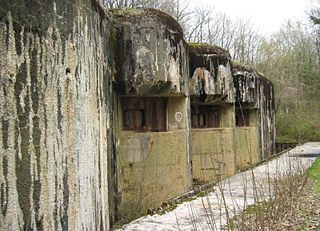
Ouvrage Latiremont is a gros ouvrage of the Maginot Line, located in the Fortified Sector of the Crusnes, sub-sector of Arrancy. It lies between the gros ouvrage Fermont and the petit ouvrage Mauvais Bois, facing Belgium. The village of Doncourt-Cités is nearby. Latiremont was active in 1939-1940, coming under direct attack in late June 1940. It surrendered to German forces on 27 June. After renovations during the Cold War, it was abandoned.

Ouvrage Hackenberg, one of the largest of the Maginot Line fortifications, is part of the Fortified Sector of Boulay. It is situated twenty kilometres east of Thionville, in the Moselle département, near the village of Veckring, on the Hackenberg. It is located between gros ouvrage Billig and petit ouvrage Coucou, facing Germany. The fort occupies the wooded Hackenberg ridge. Before World War II it was considered a showpiece of French fortification technology, and was visited by British King George VI.
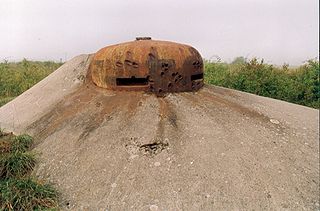
Ouvrage Laudrefang is a lesser work of the Maginot Line. Located in the Fortified Sector of Faulquemont, the ouvrage consists of one infantry block, and is located between petits ouvrages Einseling and Teting, facing Germany. Laudrefang was originally planned as a gros ouvrage. With a heavy armament for a petit ouvrage it successfully defended its neighbors against German attack during the Battle of France. Laudrefang is abandoned and flooded, and was heavily damaged by German bombardment in 1940.
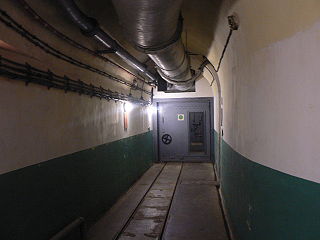
Ouvrage Saint-Gobain is a work of the Maginot Line's Alpine extension, the Alpine Line. The ouvrage consists of one entry block, one infantry block, one artillery block, one observation block and one combination block. Located in Modane, France, it is just across the valley of the Arc from Ouvrage Saint-Antoine and somewhat to the east of Ouvrage Sapey.
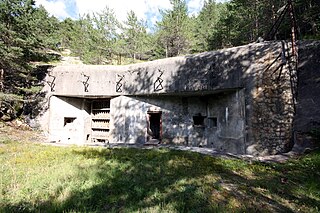
Ouvrage Saint-Antoine is a work of the Maginot Line's Alpine extension, the Alpine Line. The ouvrage consists of one entry block, one infantry block and one artillery block overlooking Modane on the way to the Col du Mont Cenis. Ouvrage Saint-Gobain is just to the north, across the mountain valley. Saint-Antoine overlooks the approaches to the Fréjus Rail Tunnel and was part of an ensemble of forts, including Saint-Gobain, Ouvrage Sapey and Fort du Replaton that guarded the French end of the tunnel and the descent from the Mont Cenis pass.
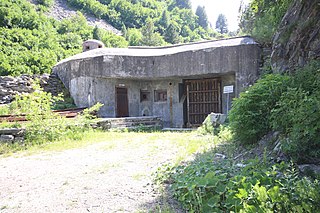
Ouvrage Le Lavoir Is a work of the Maginot Line's Alpine extension, the Alpine Line, also called the Little Maginot Line. The ouvrage consists of two entry blocks, one infantry block, three artillery blocks and one observation block 6 kilometres (3.7 mi) south of Modane, France, guarding the Col de Fréjus. The surface barracks at Le Lavoir were connected to Charmaix by an aerial tram.

Ouvrage Pas du Roc is a work of the Maginot Line's Alpine extension, the Alpine Line. The ouvrage consists of one entry blocks, one infantry block, two artillery blocks and one observation block 6 kilometres (3.7 mi) south of Modane and 1.6 kilometres (0.99 mi) east of Ouvrage Le Lavoir in the vicinity of the Col de Fréjus. The position was incomplete at the outbreak of war in 1940.

Ouvrage Roche-la-Croix is a work of the Maginot Line's Alpine extension, the Alpine Line, also known as the Little Maginot Line. The ouvrage consists of one entry block, two infantry blocks, one artillery block and two observation blocks in the vicinity of the Col de Larche. An aerial tram was provided for better access. The position is located at the top of a sheer escarpment that dominates Meyronnes and the valley of the Ubayette.
Ouvrage Saint Ours Nord-est is a lesser work of the Maginot Line's Alpine extension, the Alpine Line. The ouvrage consists of two infantry blocks. The associated underground support galleries are arranged with a short gallery connecting Blocks 1 and 2, with parallel stubs at Block 2. While it is listed in some sources as an ouvrage owing to its construction by CORF, it is more like an infantry abri or shelter.

Ouvrage Restefond is a work of the Maginot Line's Alpine extension, the Alpine Line. The ouvrage consists of one artillery block and three observation blocks at the summit of the Col de la Bonnette. The entry block and an artillery block were not completed, and a further block was never built. At 2,733 metres (8,967 ft), Restefond is the highest Maginot ouvrage.

Ouvrage La Moutière is a lesser work of the Maginot Line's Alpine extension, the Alpine Line at an altitude of 2440 meters. The ouvrage consists of one entry block, one infantry block and one observation block, with an unarmed exit block. The ouvrage supported the Ouvrage Restefond on the crest of the pass, guarding its southern flank. It also covered the Col de la Barcelonnette to the north. The position was built between 1931 and 1935.
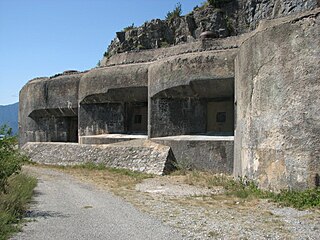
Ouvrage Rimplas is a work of the Maginot Line's Alpine extension, the Alpine Line, known also as the Little Maginot Line. The ouvrage consists of one entry block, two infantry blocks and three artillery blocks at an altitude of 986 metres (3,235 ft). It was the first ouvrage of any portion of the Maginot Line to be completed, in 1928. The ouvrage features an aerial tram entrance.

Ouvrage Gordolon is a work of the Maginot Line's Alpine extension, the Alpine Line, also known as the Little Maginot Line. The ouvrage consists of one and two infantry blocks at an altitude of 728 metres (2,388 ft). Gordolon was built by Borie contractors at a cost of 21.4 million francs. Work started in November 1931 and was completed in April 1934.

Ouvrage Flaut is a work of the Maginot Line's Alpine extension, the Alpine Line, also called the Little Maginot Line. The ouvrage consists of one entry block, one infantry block and one artillery block at an altitude of 771 metres (2,530 ft). The position was intended, acting with Ouvrage Gordolon, to stop an approach by Italian forces from the north towards Nice through the Vésibie Valley.

Ouvrage Plan Caval is a lesser work of the Maginot Line's Alpine extension, the Alpine Line, also known as the Little Maginot Line. The ouvrage consists of two infantry blocks and one observation block facing Italy. The ouvrage is located on the heights of L'Authion, surrounded by older fortifications. Three additional blocks were planned to make it a gros ouvrage but were not built. Cost for the full ensemble was estimated at 23 million francs.

Ouvrage Col de Brouis is a work of the Maginot Line's Alpine extension, the Alpine Line, also known as the Little Maginot Line. The ouvrage consists of one entry block and two artillery blocks facing Italy at an altitude of 871 metres (2,858 ft). The ouvrage is located about one kilometer north of Monte Grosso. It was placed to control the Col de Brouis and the D 2204 road between the Breil and Sospel.

Ouvrage Monte Grosso is a work of the Maginot Line's Alpine extension, the Alpine Line, also known as the Little Maginot Line. The ouvrage consists of one entry block, four artillery blocks and two observation blocks facing Italy. It was the largest ouvrage in the Alps It is part of the fortifications surrounding Sospel, which protect the approaches to Nice from the north.

Ouvrage Saint-Roch is a work of the Maginot Line's Alpine extension, the Alpine Line, also known as the Little Maginot Line. Small for a gros ouvrages, the ouvrage consists of one entry block, one artillery block and two observation blocks overlooking Sospel at an altitude of 426 metres (1,398 ft). The position is located just to the southwest of Sospel, its entrance block in a narrow valley and the artillery block on the other side of the ridge overlooking Sospel. The ouvrage is laid out along a single line, with the entry block to the rear, immediately followed by the usine, with barracks farther along and Blocks 2 and 3 at intervals. The position's main armament is concentrated in Block 4, a massive blockhouse designed to protect against rockfalls from higher up the mountain.

Ouvrage Castillon is a work of the Maginot Line's Alpine extension, the Alpine Line, also called the Little Maginot Line. The ouvrage consists of one entry block, two infantry blocks, and two artillery blocks in a narrow ridge just to the west of Castillon, Alpes-Maritimes. It was built on the original site of Castillon, destroyed by an earthquake in 1887. It is the next gros ouvrage in the line to the north of Ouvrage Sainte-Agnès, and is within firing range of the Mediterranean coastline.

Ouvrage Roquebrune is a work of the Maginot Line's Alpine extension, the Alpine Line. The ouvrage consists of one entry block, two artillery blocks and one observation block facing Italy. The fortification is located on the heights behind Roquebrune at an elevation of 321 meters overlooking Cap Martin and the bays of Roquebrune and Menton. The ouvrage was manned by 293 men of the 58th Demi-Brigade Alpin de Forteresse (DBAF), supported by the 157th Régiment d'Artillerie de Position (RAP), under the command of Captain Gayot.















